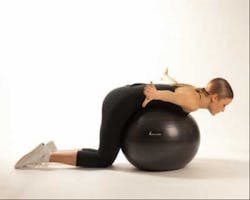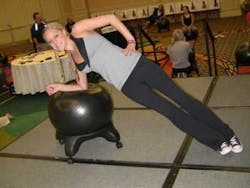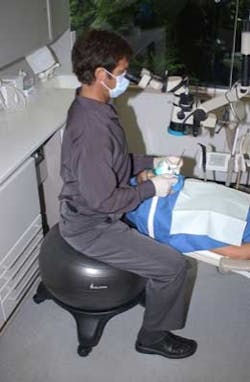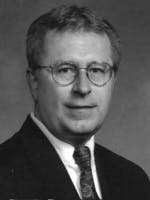Regular exercise can improve posture, decrease symptoms of pain and discomfort
Dentistry has come a long way over the last 150 years. The evolution of anesthesia, dental techniques, materials, equipment, and approaches has come a long way from standing up with a pair of pliers and a can of ether. Pain appears to be an accepted part of the dental profession, and its incidence is worsening. The patients are pain free but how about the dental staff? Our ultimate career goals are to be efficient and effective and healthy. However, these goals can be impacted by the presence of mechanical neck and low back pain. Daily discomfort continues to be tolerated day in and day out. Evidence from the Scandinavian literature as early as the 1950s reports complaints of neck, shoulder and low back pain within the dental profession (Seyffarth). Eccles and Powell reported in 1967 that the practice of dentistry leads to excessive fatigue and to certain occupational illnesses and disabilities. Although dental practice transitioned from standing postures to sitting postures for most patient care tasks in the mid-1960s, a decrease in the prevalence of reported discomfort has not been reported (Rundcrantz BL). Kilpatrick observed, “Whether in ancient times or today, one observes a common physical profile, an unnatural body form reflecting degrees of contortion & distortion which range from moderate to extreme … a great deal has changed & improved in the art & science of dentistry over the centuries, but little has changed in the manner of work” (Kilpatrick). Orthopedic research has shown that 70 to 80% of the population will experience transient neck or low back pain during the course of their lives (Spratt, Kelsey). Studies have found that 23% to 79% have symptoms that persist or recur (Toroptsova, Croft, Carey, van den Hoogen). A majority of dentists and hygienists have musculoskeletal complaints related to the back and neck (Oberg, Murphy). The prevalence of neck pain and lower back pain was reported at 52% and 58%, respectively, in the ADA News in June 2010, with similar findings reported in the ADA member survey in 2007. The work of dentistry relies a great deal on the upper body in the operatory, particularly the musculature of the shoulder. Shoulder muscles are largely responsible for the dynamic stability and joint motion of the glenohumeral joint. When the shoulder muscles fatigue, joint mechanics become altered, thus possibly leading to pathologies such as tendonitis, impingement, and even subluxations or dislocations (McQuade et al). According to Escamilla et al, if normal scapular movements are disrupted by abnormal scapular muscle firing patterns, weakness, fatigue, or injury, the shoulder complex functions less efficiency and injury risk increases (Escamilla et al). Prolonged sitting in a slouched seated position, also increases the intradiscal pressure of the lumbar spine increased significantly (Anderssen, et al).Pain in the dental practice can result from prolonged atypical posturing and further complicated by deconditioning. The cumulative effects of abnormal stresses and strains on the clinician have been well documented in the literature…. So, what can clinicians do? Is it possible for dental professionals to counteract the ill-effects of their profession on their bodies by participating in a regular exercise routine?
One option is dynamic sitting on the Evolution chair by Posture Perfect Solutions, which provides us with a unique alternative to typical sitting. The Evolution chair provides an opportunity to actively “participate” in the act of sitting, and while this may not be a good fit for all practitioners, it is yet another option to consider. Dynamic sitting allows us to avoid the habitual slouched sitting posture that our mothers always warned us about. We are continuously moving, adjusting and repositioning ourselves throughout the day thus counteracting our typical “holding patterns” of poor posture and perhaps saving our lives!
Efficiency, effectiveness and career longevity may be positively impacted by the fitness of the operator and their choice of seating. So when considering career longevity with the hope of making it to the end of your career in great shape, get on the ball!
Seyffarth H, Steen Johnson S. The dentist’s working posture and musculoskeletal disorders. Tandlaegebladet 1954; 4:139-159 Eccles JD, Powell M. The health of dentists: A survey in South Wales 1965/1966. British Dental Journal 1967; 379-387Rundcrantz BL. Pain and Discomfort in the Musculoskeletal System among Dentists. Lund Sweden: Department of Physical Therapy, University of Lund, 1991; 3-59Kilpatrick, H. Work Simplification in Dental Practice: Applied Time and Motion Studies. 3rd edition. W.B. Saunders Company Philadelphia, 1974Spratt KF, Lehmann TR, et al A New Approach to the Low Back Physical Examination: Behavioral Assessment of Mechanical Signs. Spine, Volume 15, p. 96-102, 1990. Kelsey JL, White AA. Epidemiology and Impact of Low Back Pain. Spine, Volume 5, p.133-42, 1980.Toroptsova N., Benevolenskaya L., et al. "Cross-Sectional" Study of Low Back Pain among Workers at an Industrial Enterprise in Russia. Spine, Volume 20, p. 328-332, 1995. Croft PR, Macfarlane GJ, et al. Outcome of low back pain in general practice: a prospective study. British Medical Journal Volume 316, p. 1356-1359, 1998. Carey TS, Garrett JM, et al. Recurrence and care seeking after acute back pain. Results of a Long Term Follow-up Study. Medical Care, Volume 37. p. 157-164, 1999.van den Hoogen, Koes BW, et al. On the Course of Low Back Pain in General Practice. A one-year follow up study. Annals of Rheumatological Disability, Volume 57, p. 13-19, 1998.Oberg, T. et al. Musculoskeletal Complaints in Dental Hygiene: A Survey from a Swedish Country. Journal of Dental Hygiene. Vol 67, Number 5, 257-261, 1993.Murphy, D. editor, Ergonomics and the Dental Care Worker. American Public Association, 1998.ADA News June 21, 2010ADA member survey 2007McQuade KJ, Dawson J, Smidt GL. Scapulothoracic muscle fatigue associated with alterations in scapulohumeral rhythm kinematics during maximum resistive shoulder elevation. JOSPT. 1998; 28(2):74–80.Escamilla RF, Yamashiro K, Paulos L, Andrews JR. Shoulder muscle activity and function in common shoulder rehabilitation exercises. J. Sports Med. 2009; 39(8):663-85. Sochaniwskyj, A. R Koheil, K Bablich, M Milner, W Lotto. Dynamic monitoring of sitting posture for children with spastic cerebral palsy. Clinical biomechanics. Volume: 6, Issue: 3. 1991Dieter Breithecker, P. “Ergodynamic” work station design and its effect on physiologically correct body behavior, attention span and concentration at school. Federal working group on the development of posture and exercise V. Matthias-Claudius-Strabe 14 D-65185 Wiesbaden, Germany. 2007Bauman, A. Updating the evidence that physical activity is good for health: an epidemiological review 2000–2003. Journal of Science and Medicine in Sport. Volume 7, Issue 1, Supplement 1. 2004 Andersson BJ, Ortengren R, Nachemson AL, Elfström G, Broman H. The sitting posture: an electromyographic and discometric study. Orthopedic Clinics of North America. 1975 Jan; 6(1):105-20.www.mayoclinic.com/health/exercisewww.cdc.gov/physicalactivity/everyone/health/index.htmlMarshall, P.W.M and Desai, I. Electromyographic analysis of upper body, lower body and abdominal muscles during advanced swiss ball exercises. Journal of strength and conditioning research. 2010. Women’s Health Magazine survey November 2009Alpa V. Patel, Leslie Bernstein, Anusila Deka, Heather Spencer Feigelson, Peter T. Campbell, 5 Susan M. Gapstur, Graham A. Colditz, and Michael J. Thun. Leisure Time Spent Sitting in Relation to Total Mortality in a Prospective Cohort of US Adults. American Journal of Epidemiology, 2010Dr Toni Yancey. Instant Recess: Building a Fit Nation 10 Minutes at a Time. University of California Press. 2010




